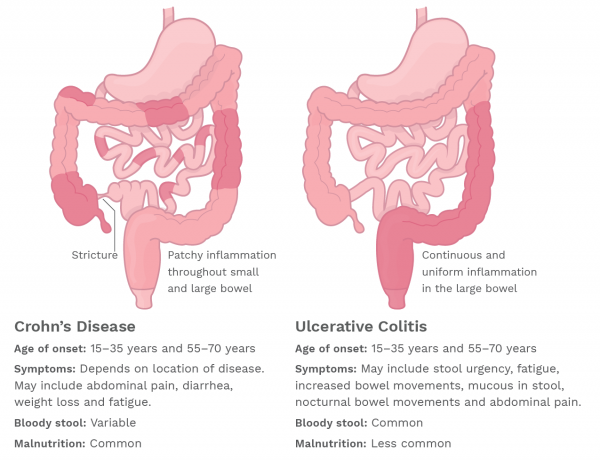Overview of Ulcerative Colitis
While it can be overwhelming to receive a chronic disease diagnosis, learning all you can about ulcerative colitis will prepare you to manage your symptoms and live a full life.
Have you or a loved one been recently diagnosed with ulcerative colitis? Or were you diagnosed years ago but still don’t fully understand your disease? Check out our latest video chat to learn more.
Ulcerative colitis is a chronic inflammatory disease of the large intestine, also called the colon, that affects the lining of the colon and causes small sores, or ulcers, to form.
Those ulcers produce pus and mucous, which cause abdominal pain and the need to frequently empty your colon.
Causes of Ulcerative Colitis
Ulcerative colitis is the result of several factors that are not yet well understood. Abnormal immune response, genetics, microbiome, and environmental factors all contribute to ulcerative colitis.
Research suggests that ulcerative colitis could be triggered by an interaction between a virus or bacterial infection in the colon and the body’s immune response.
-
Typically, the cells and proteins that make up your immune system protect you from infection.
-
A normal immune response would cause temporary inflammation to combat an illness or infection. The inflammation would then go away once you are healthy and free of the illness.
-
In ulcerative colitis patients, the inflammation persists long after the immune system should have finished its job. The body continues to send white blood cells into the lining of the intestines, where they produce chronic inflammation and ulcers.
Who is Affected?
Ulcerative colitis can occur at any age, though most people are diagnosed in their mid-30s.
-
Men and women are equally likely to be affected, but older men are more likely to be diagnosed than older women.
-
The risk of developing ulcerative colitis is between 1.6 percent and 30 percent if you have a first-degree relative with the disease.1-3
-
It is not possible to confidently predict which, if any, family members will develop ulcerative colitis, even though there is an increased risk of IBD based on family history.
-
Ulcerative colitis can affect people of any racial or ethnic group.
Ulcerative Colitis vs. Crohn’s Disease
Ulcerative colitis and Crohn’s disease share similar symptoms and they are both types of inflammatory bowel disease (IBD), but they are not the same illness and they affect different areas of the GI tract.
- Can affect any part of the GI tract from the mouth to the anus
- Can affect the entire thickness of the bowel wall
- Only the colon and rectum (also known as the large intestine) are affected
- Affects the inner-most lining of the large intestine

